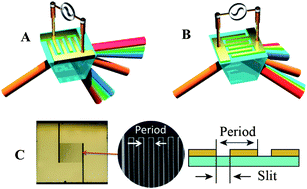Combined surface plasmon resonance and impedance spectroscopy systems for biosensing
Abstract
Combined surface plasmon resonance and electrochemical impedance spectroscopy (SP-EIS) biosensing systems have been developed. They use a sensor chip consisting of micrometer sized interdigitated metal electrodes (IDEs) which effectively act as a surface plasmon supporting structure. In addition, the interdigitated electrodes exhibit the properties of an optical dispersive grating reflecting white light into the diffraction orders. Direct surface plasmon spectral analysis is possible by using the first order of diffraction and has been used as a novel principle for a simplified optical set-up. SP-EIS is a promising technology for a variety of conductometric and SPR mono- and multisensing applications in portable or stationary platforms.


 Please wait while we load your content...
Please wait while we load your content...